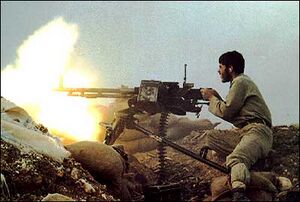Operation Renewed Insurgence
| Operation Renewed Insurgence | |||||||
|---|---|---|---|---|---|---|---|
| Part of Operation Enduring Sunrise (Third Great War) | |||||||
 A Senar heavy machinegun fires on Gagian soldiers. | |||||||
| |||||||
| Belligerents | |||||||
|
Third Coalition Supported By |
Laurillac Pact Supported By | ||||||
| Commanders and leaders | |||||||
|
|
| ||||||
| Units involved | |||||||
|
|
| ||||||
| Strength | |||||||
| 15,400 soldiers | 9,000 soldiers | ||||||
| Casualties and losses | |||||||
|
351 killed 800 wounded |
704 killed >400 wounded 2,000 captured | ||||||
Operation Renewed Insurgence was a Gagian offensive conducted against Senar forces in the final days of Operation Enduring Sunrise. By 1981, with the onset of the Invasion of Gagium, the Third Coalition powers had turned their attention towards neutralizing Gagium rather than fighting Narulian and Gagian forces in the Gulf of Atily. A series of failed offensives, including defeat in the attempt to take the Senarwan capital of Paluri, had decimated Gagian forces. Narulian correspondance with the Gagian government indicated unwillingness to continue fighting the Coalition-backed Gulf powers, and Narulia wouldn't take part in any major offensives in the final months of the war.
Risking complete encirclement in the mountains of Senarwa, Lt. General Matthias Bacque ordered the 8th Infantry Division to begin a counteroffensive against Senarwan forces, promising support from the 13th Armored Division as well as air support. The offensive began on 3 June, and the 8th Division was able to initially make important gains in capturing several villages. However, lacking promised reinforcements as General Bacque was ordered to retreat as part of a planned evacuation, the 8th Division found itself encircled by the end of the first week of fighting.
On 12 June, fighting ceased after the Gagian forces had lost all of their gains and were forced to retreat uphill. By the end of fighting, nearly a fourth of the Gagian forces were captured and over 1,000 soldiers were either killed or wounded. The 8th Division was on the brink of collapse immediately before the signing of the Zuhalurra Armistice ended hostilities in the region.